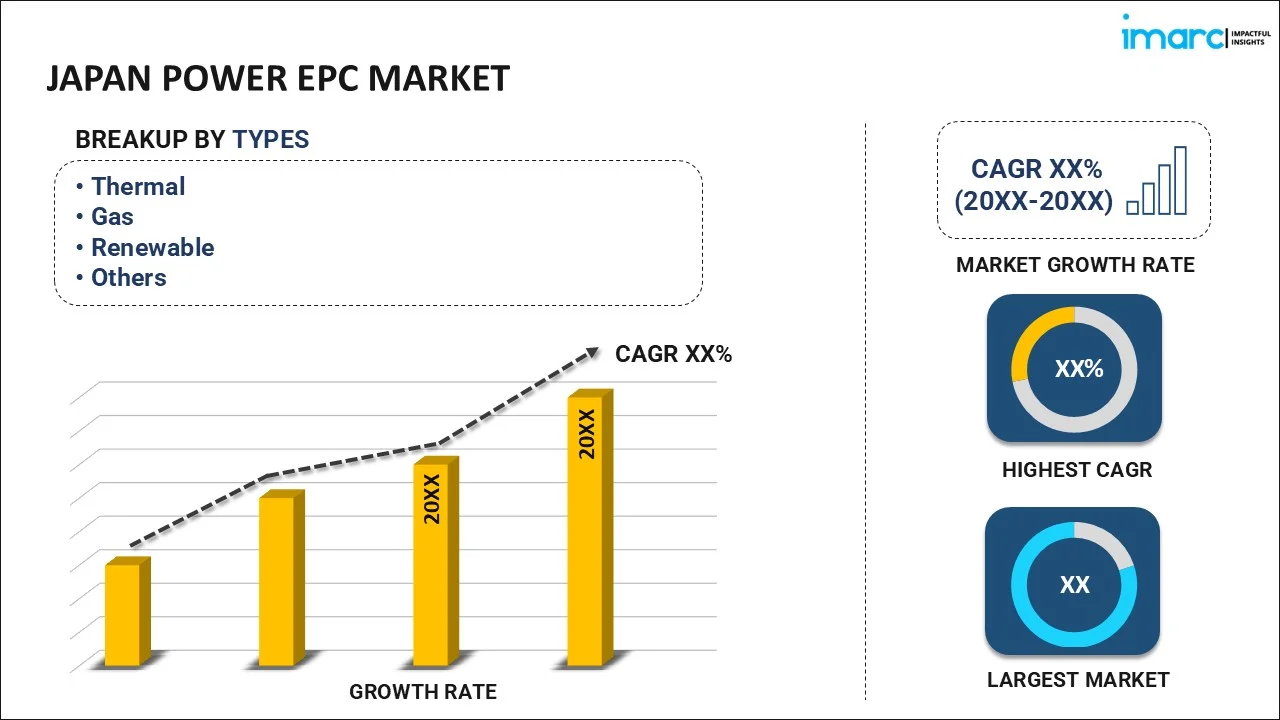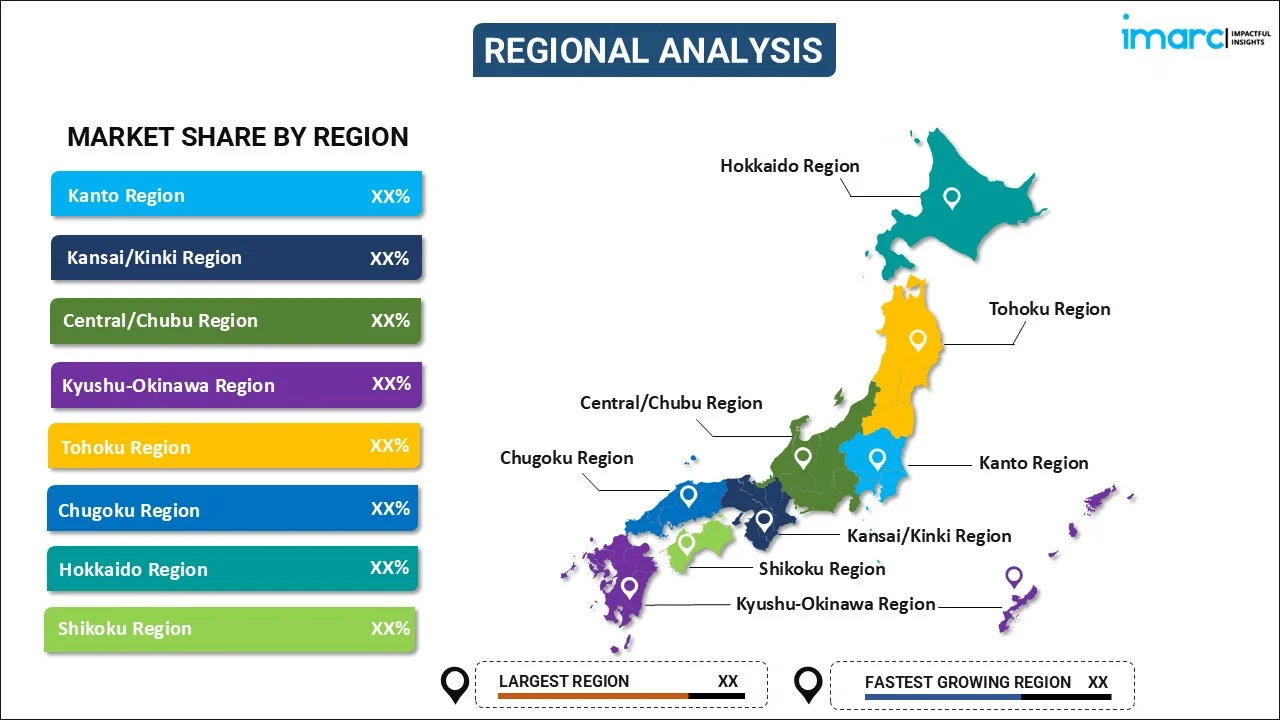
Japan Power EPC Market Size, Share, Trends and Forecast by Type and Region, 2025-2033
Japan Power EPC Market Overview:
The Japan power EPC market size reached USD 40,433.50 Million in 2024. Looking forward, IMARC Group expects the market to reach USD 56,568.94 Million by 2033, exhibiting a growth rate (CAGR) of 3.80% during 2025-2033. The Japan power EPC market share is growing owing to government-backed initiatives aimed at achieving carbon neutrality. Increased investments in renewable energy, especially offshore wind projects, alongside energy efficiency mandates, are driving the demand for specialized EPC services, fostering growth in clean energy infrastructure and sustainability projects.
|
Report Attribute
|
Key Statistics
|
|---|---|
|
Base Year
|
2024
|
|
Forecast Years
|
2025-2033
|
|
Historical Years
|
2019-2024
|
| Market Size in 2024 | USD 40,433.50 Million |
| Market Forecast in 2033 | USD 56,568.94 Million |
| Market Growth Rate (2025-2033) | 3.80% |
Japan Power EPC Market Trends:
Government Initiatives and Energy Transition Goals
Japan intends to reach carbon neutrality by 2050, committing to considerable investments in renewable energy options like solar, wind, and geothermal energy. The governing authority is also concentrating on improving energy security via local energy generation. Consequently, public-private partnerships and incentives are aiding engineering, procurement, and construction (EPC) firms in obtaining renewable energy projects, broadening market possibilities. The execution of energy transition policies and frameworks, such as subsidies and tax benefits, is hastening the change from fossil fuel-dependent energy systems to cleaner options, boosting the need for EPC services in power generation and grid infrastructure. In 2025, JERA headed a consortium to obtain the rights for a 615-MW offshore wind initiative in Aomori Prefecture, Japan. Scheduled to commence in June 2030, the project will become one of Japan's largest offshore wind energy initiatives. The consortium intends to aid Japan's carbon neutrality objectives by collaborating closely with local communities and the fishing sector.
Increasing Investment in Offshore Wind Energy
Japan is making significant strides in offshore wind energy development, aiming to become one of the international leaders in this sector. The country has vast potential for offshore wind power, particularly in regions with strong, consistent winds. Government-backed initiatives are fostering investment in offshore wind farms. For example, in 2025, Mitsui OSK Lines (MOL) and Fukada Salvage & Marine Works signed a memorandum of understanding to develop specialized vessels for transporting and installing floating offshore wind turbines in Japan. This initiative supports Japan’s push for carbon neutrality by 2050 and focuses on expanding floating wind energy in deep-sea areas. The partnership aims to address the need for specialized vessels and mooring systems for these projects. This growing focus on offshore wind energy is driving the demand for power EPC services, as the complex nature of offshore projects requires specialized construction, installation, and maintenance expertise. The expansion of port facilities, turbine installation infrastructure, and subsea cabling projects are increasing, providing new opportunities for EPC contractors to participate in this rapidly growing segment of Japan’s power generation landscape.
Growing Focus on Energy Efficiency and Sustainability
As part of Japan’s energy transition goals, the country is setting stringent energy efficiency standards for new power plants and grid infrastructure. This includes optimizing existing plants to reduce emissions, improve efficiency, and extend the life cycle of assets. EPC contractors are being tasked with upgrading or retrofitting aging facilities to meet these sustainability standards, particularly in coal and gas-fired power plants. Additionally, Japan’s focus on reducing its overall carbon footprint is leading to the incorporation of green technologies, like carbon capture and storage (CCS) systems, into new and existing power projects. For instance, in 2024, Japan's JOGMEC signed a consignment contract with ENEOS, JX Nippon Oil & Gas, J-POWER, and West Japan Carbon Dioxide Storage Survey for engineering design work related to the Offshore Western Kyushu CCS project. This initiative aims to capture and store 1.7 million tons of CO2 annually by FY2030. The project involves capturing CO2 from refineries and power plants, transporting it via ship and pipeline to offshore storage sites. These efforts require advanced EPC capabilities to ensure compliance with environmental regulations and to improve the overall sustainability of Japan’s energy system.
Japan Power EPC Market Segmentation:
IMARC Group provides an analysis of the key trends in each segment of the market, along with forecasts at the regional level for 2025-2033. Our report has categorized the market based on type.
Type Insights:

- Thermal
- Gas
- Renewable
- Nuclear
- Others
The report has provided a detailed breakup and analysis of the market based on the type. This includes thermal, gas, renewable, nuclear, and others.
Regional Insights:

- Kanto Region
- Kansai/Kinki Region
- Central/ Chubu Region
- Kyushu-Okinawa Region
- Tohoku Region
- Chugoku Region
- Hokkaido Region
- Shikoku Region
The report has also provided a comprehensive analysis of all the major regional markets, which include Kanto Region, Kansai/Kinki Region, Central/ Chubu Region, Kyushu-Okinawa Region, Tohoku Region, Chugoku Region, Hokkaido Region, and Shikoku Region.
Competitive Landscape:
The market research report has also provided a comprehensive analysis of the competitive landscape. Competitive analysis such as market structure, key player positioning, top winning strategies, competitive dashboard, and company evaluation quadrant has been covered in the report. Also, detailed profiles of all major companies have been provided.
Japan Power EPC Market News:
- In July 2024, Sumitomo Corporation and JGC Japan Corporation agreed to explore collaboration in the floating offshore wind (FOW) power generation sector. Their partnership aimed to address bottlenecks in the production and supply of floater components by enhancing efficiency and mass production. This collaboration aimed to support the growing offshore wind power industry and contribute to a decarbonized society.
- In May 2024, juwi Shizen Energy completed a 121 MW solar power plant in Sanda City, Hyogo Prefecture, Japan. This facility will provide 85 MW of renewable energy to a major utility company, reducing CO2 emissions by 41,000 tons annually. The project, built on a former golf course, generated 143 million kWh per year, enough to power 34,200 households.
Japan Power EPC Market Report Coverage:
| Report Features | Details |
|---|---|
| Base Year of the Analysis | 2024 |
| Historical Period | 2019-2024 |
| Forecast Period | 2025-2033 |
| Units | Million USD |
| Scope of the Report |
Exploration of Historical Trends and Market Outlook, Industry Catalysts and Challenges, Segment-Wise Historical and Future Market Assessment:
|
| Types Covered | Thermal, Gas, Renewable, Nuclear, Others |
| Regions Covered | Kanto Region, Kansai/Kinki Region, Central/ Chubu Region, Kyushu-Okinawa Region, Tohoku Region, Chugoku Region, Hokkaido Region, Shikoku Region |
| Customization Scope | 10% Free Customization |
| Post-Sale Analyst Support | 10-12 Weeks |
| Delivery Format | PDF and Excel through Email (We can also provide the editable version of the report in PPT/Word format on special request) |
Key Questions Answered in This Report:
- How has the Japan power EPC market performed so far and how will it perform in the coming years?
- What is the breakup of the Japan power EPC market on the basis of type?
- What is the breakup of the Japan power EPC market on the basis of region?
- What are the various stages in the value chain of the Japan power EPC market?
- What are the key driving factors and challenges in the Japan power EPC market?
- What is the structure of the Japan power EPC market and who are the key players?
- What is the degree of competition in the Japan power EPC market?
Key Benefits for Stakeholders:
- IMARC’s industry report offers a comprehensive quantitative analysis of various market segments, historical and current market trends, market forecasts, and dynamics of the Japan power EPC market from 2019-2033.
- The research report provides the latest information on the market drivers, challenges, and opportunities in the Japan power EPC market.
- Porter's five forces analysis assist stakeholders in assessing the impact of new entrants, competitive rivalry, supplier power, buyer power, and the threat of substitution. It helps stakeholders to analyze the level of competition within the Japan power EPC industry and its attractiveness.
- Competitive landscape allows stakeholders to understand their competitive environment and provides an insight into the current positions of key players in the market.
Need more help?
- Speak to our experienced analysts for insights on the current market scenarios.
- Include additional segments and countries to customize the report as per your requirement.
- Gain an unparalleled competitive advantage in your domain by understanding how to utilize the report and positively impacting your operations and revenue.
- For further assistance, please connect with our analysts.
 Inquire Before Buying
Inquire Before Buying
 Speak to an Analyst
Speak to an Analyst
 Request Brochure
Request Brochure
 Request Customization
Request Customization




.webp)




.webp)












